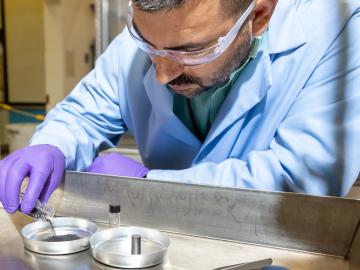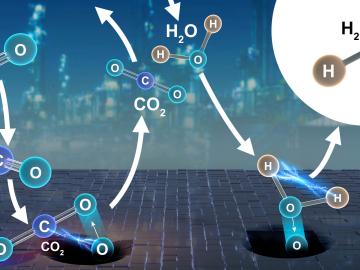
Filter News
Area of Research
- Advanced Manufacturing (8)
- Biological Systems (1)
- Biology and Environment (46)
- Building Technologies (2)
- Computational Biology (2)
- Computational Engineering (1)
- Computer Science (3)
- Electricity and Smart Grid (1)
- Energy Science (90)
- Energy Sciences (1)
- Functional Materials for Energy (1)
- Fusion and Fission (11)
- Fusion Energy (8)
- Isotopes (6)
- Materials (57)
- Materials for Computing (10)
- National Security (27)
- Neutron Science (120)
- Nuclear Science and Technology (19)
- Nuclear Systems Modeling, Simulation and Validation (1)
- Quantum information Science (3)
- Supercomputing (42)
News Type
News Topics
- (-) Advanced Reactors (39)
- (-) Biomedical (71)
- (-) Cybersecurity (35)
- (-) Neutron Science (168)
- 3-D Printing/Advanced Manufacturing (142)
- Artificial Intelligence (129)
- Big Data (74)
- Bioenergy (110)
- Biology (126)
- Biotechnology (38)
- Buildings (69)
- Chemical Sciences (85)
- Clean Water (32)
- Composites (34)
- Computer Science (220)
- Coronavirus (47)
- Critical Materials (28)
- Education (5)
- Element Discovery (1)
- Emergency (4)
- Energy Storage (109)
- Environment (210)
- Exascale Computing (67)
- Fossil Energy (8)
- Frontier (63)
- Fusion (64)
- Grid (72)
- High-Performance Computing (129)
- Hydropower (12)
- Irradiation (3)
- Isotopes (60)
- ITER (9)
- Machine Learning (65)
- Materials (155)
- Materials Science (149)
- Mathematics (11)
- Mercury (12)
- Microelectronics (4)
- Microscopy (52)
- Molten Salt (10)
- Nanotechnology (60)
- National Security (83)
- Nuclear Energy (117)
- Partnerships (68)
- Physics (64)
- Polymers (32)
- Quantum Computing (53)
- Quantum Science (92)
- Security (29)
- Simulation (63)
- Software (1)
- Space Exploration (26)
- Statistics (4)
- Summit (71)
- Transportation (98)
Media Contacts

Quanex Building Products has signed a non-exclusive agreement to license a method to produce insulating material from ORNL. The low-cost material can be used as an additive to increase thermal insulation performance and improve energy efficiency when applied to a variety of building products.

A modern, healthy transportation system is vital to the nation’s economic security and the American standard of living. The U.S. Department of Energy’s Oak Ridge National Laboratory (ORNL) is engaged in a broad portfolio of scientific research for improved mobility

Researchers used neutron scattering at Oak Ridge National Laboratory’s Spallation Neutron Source to probe the structure of a colorful new material that may pave the way for improved sensors and vivid displays.

Ask Tyler Gerczak to find a negative in working at the Department of Energy’s Oak Ridge National Laboratory, and his only complaint is the summer weather. It is not as forgiving as the summers in Pulaski, Wisconsin, his hometown.

Electro-Active Technologies, Inc., of Knoxville, Tenn., has exclusively licensed two biorefinery technologies invented and patented by the startup’s co-founders while working at the Department of Energy’s Oak Ridge National Laboratory. The technologies work as a system that converts organic waste into renewable hydrogen gas for use as a biofuel.

Using additive manufacturing, scientists experimenting with tungsten at Oak Ridge National Laboratory hope to unlock new potential of the high-performance heat-transferring material used to protect components from the plasma inside a fusion reactor. Fusion requires hydrogen isotopes to reach millions of degrees.

A new method developed at Oak Ridge National Laboratory improves the energy efficiency of a desalination process known as solar-thermal evaporation.

Collaborators at the Department of Energy’s Oak Ridge National Laboratory and U.S. universities used neutron scattering and other advanced characterization techniques to study how a prominent catalyst enables the “water-gas shift” reaction to purify and generate hydrogen at industrial scale.
A team of scientists led by Oak Ridge National Laboratory have discovered the specific gene that controls an important symbiotic relationship between plants and soil fungi, and successfully facilitated the symbiosis in a plant that

Scientists at Oak Ridge National Laboratory studying quantum communications have discovered a more practical way to share secret messages among three parties, which could ultimately lead to better cybersecurity for the electric grid


